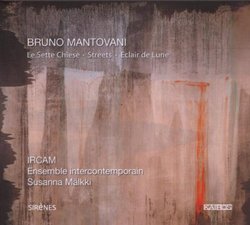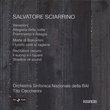| All Artists: Bruno Mantovani, Susanna Mälkki, Ensemble InterContemporain Title: Bruno Manotvani: Le Sette Chiese; Streets; Éclair de Lune Members Wishing: 0 Total Copies: 0 Label: Kairos Release Date: 11/1/2008 Genre: Classical Style: Chamber Music Number of Discs: 1 SwapaCD Credits: 1 |
Search - Bruno Mantovani, Susanna Mälkki, Ensemble InterContemporain :: Bruno Manotvani: Le Sette Chiese; Streets; Éclair de Lune
 | Bruno Mantovani, Susanna Mälkki, Ensemble InterContemporain Bruno Manotvani: Le Sette Chiese; Streets; Éclair de Lune Genre: Classical
|
Larger Image |
CD DetailsSimilar CDs |
CD ReviewsNot always profound, but engaging Christopher Culver | 12/06/2009 (3 out of 5 stars) "The young French composer Bruno Mantovani (born 1974) is one of the up-and-coming figures of the contemporary classical world, winning one commission after another and having his work toured internationally by the Ensemble Intercontemporain. However, as yet he's little represented in recordings. This Kairos release, where Susanna Malkki leads the EIC in three works for ensemble, is one of the few places to hear his work on disc.
"Streets" (2007) was inspired by a walk through New York, a cityscape where one notices only the general buzz and not the myriad individual details. "Eclair de lune" (2006) starts with a sonata for piano, but then proceeds to an orchestral soundscape which interacts with a tape part of altered tin drum sounds. The most ambitious work here, however, is "Le Sette Chiese" (2002) which represents over nine movements the eponymous monument in Bologna. "Le Sette Chiese" makes extreme use of spatialization, and though this mere two-channel recording sadly cannot reproduce it fully, the stereophonic effects are sure to delight you. Throughout these pieces I found myself drawing comparisons to other composers. Often there is almost absurd virtuosity a la Ferneyhough -- can anyone besides the EIC play this? -- with splashes of colour reminiscent of Unsuk Chin. Some piano writing reminds me of Dusapin's etudes. The spatialization and writing for brass recalls Luciano Berio. But most of all, one senses the blur and evocation of daily life of Debussy -- "Le Sette Chiese" is a veritable latter-day "Images". (The influence of Lachenmann, however, is much less heard than in some other composers of this generation.) But note that all these associations are with the avant-garde -- make no mistake, Mantovani's music fits squarely within modernism. If there are gentle melodies here, then they exist only in the same way as in, say, Debussy's "Jeux", that is one incidental layer in a complex fabric. The liner notes include a presentation of the pieces by Mantovani, including a movement-by-movement commentary on "Le Sette Chiesi" and a map of the Bologna complex. There's also an essay by Christophe Ghristi, but this is a tiresome four-page gush about how clever and personable Mantovani is, and doesn't tell us much. From the music here, I feel that Mantovani is still working towards a mature style. While "Le Sette Chiesi" is quite memorable, the other two pieces seem almost devoid of content (that they are the more recent doesn't bode well). Still, there's something rather promising about all this, and I would recommend it with caution if you want to keep up on cutting-edge European composition." |

 Track Listings (11) - Disc #1
Track Listings (11) - Disc #1



